The Memory Performance Review – 6 Kits / 30 Games & Real World Benches Featuring Corsair DDR5 6400
We borrowed a Corsair DOMINATOR DDR5 6400MHz CL38 2x16GB kit from JPR last weekend and compared it against five other similar 2x16GB memory kits. We used a full set of benchmarking tools and 30 games to see if faster DDR5 speeds or lower latency make any practical performance difference for gamers or creators.
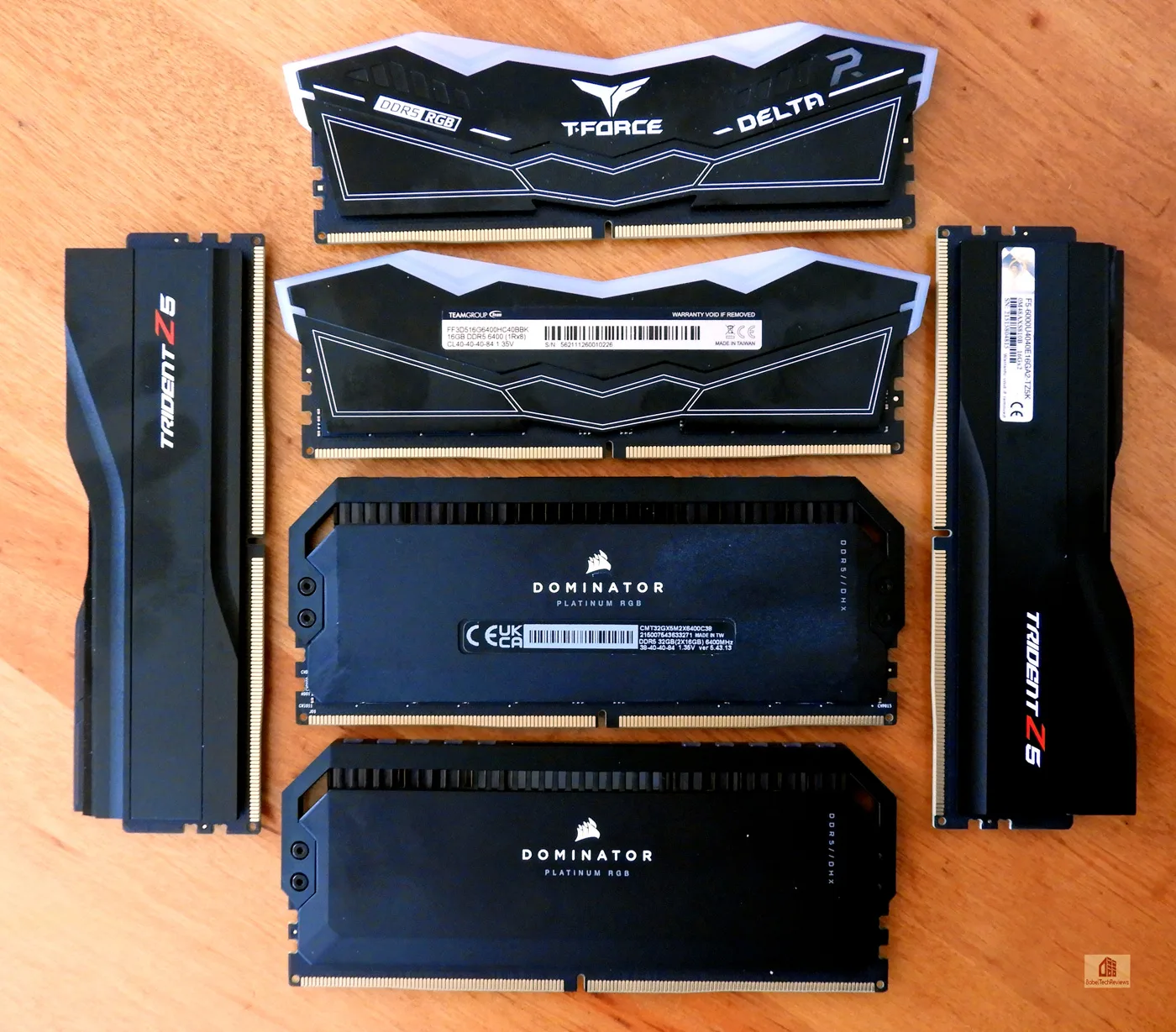
This is the third installment of BTR’s memory review series and we already compared the T-FORCE DELTA RGB 6400MHz CL40 DDR5 2x16GB memory kit with 2x16GB T-FORCE DARK Z 3600MHz CL18 DDR4 and 2x16GB T-FORCE VULCAN 5200 CL40 DDR5 kits. For this review, we purchased two identical G.SKILL DDR5 6000 2x16GB kits from Amazon – the only difference is that one kit is CL36 and the other is CL40.
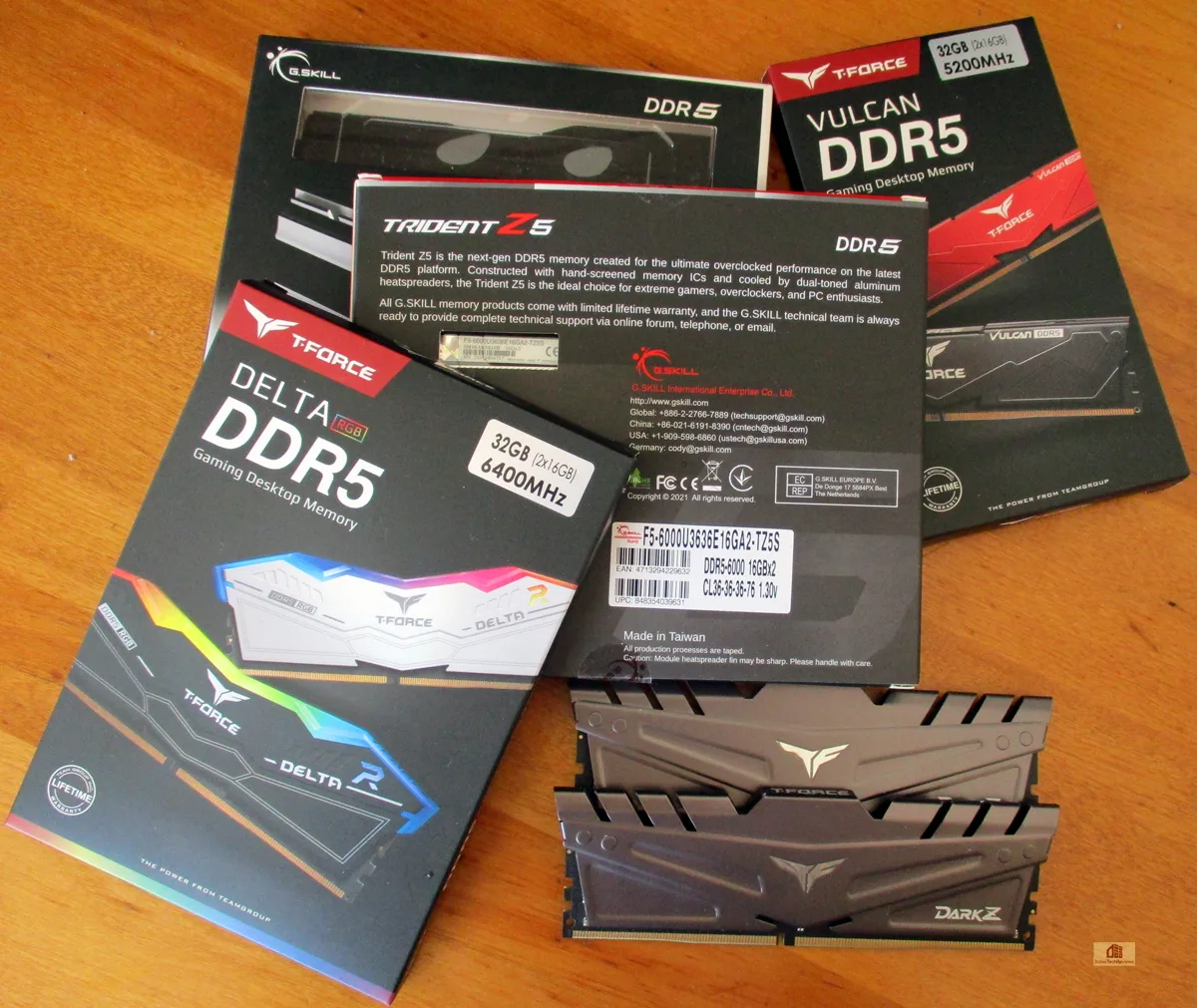
Last year, BTR ran an extensive set of tests comparing DDR4 3600MHz CL18 with CL16 and the performance results were very similar for gaming, so our T-FORCE DARK Z 3600MHz CL18 2x16GB kit is representative of today’s fast DDR4. We started over with new benchmarks and have updated our testing tools to compare the relative performance of six memory kits using an i9-12900KF.
Since no motherboard supports both types of memory, gamers have a choice of using their current DDR4 memory on a Z690 DDR4 motherboard or buying new memory for a Z690 DDR5 motherboard. When BTR originally upgraded its flagship PC from an i9-10900K to an i9-12900KF, we picked a solid midrange ASUS Prime Z690-P D4 board for our DDR4 3600 memory. We then purchased an ASUS ROG Maximus Apex Z690 DDR5 motherboard for this memory review series.
Here are the six memory kits that we are comparing:
- Corsair DOMINATOR (PC5-51200) DDR5 6400MHz CL38 2x16GB
- T-FORCE DELTA (PC5-51200) DDR5 6400MHz CL40 2x16GB
- G.SKILL Trident Z5 (PC5-48000) DDR5 6000MHz CL36 2x16GB
- G.SKILL Trident Z5 (PC5-48000) DDR5 6000MHz CL40 2x16GB
- T-FORCE VULCAN (PC5-41600) DDR5 5200MHz CL40 2x16GB
- T-FORCE VULCAN DARKZ (PC4-28800) DDR4 3600MHz CL18 2x16GB
Just like with video cards, predatory resellers have been buying large quantities of DDR5 at MSRP to resell them at inflated prices. Fortunately, DDR5 supply is rapidly increasing and it is now possible to buy Corsair DDR5 at or near MSRP.
Testing Platform, Product Specifications & Features
Our testing platform is a recent clean installation of Windows 11 Professional, using an Intel Core i9-12900KF at stock settings using either a 1) ASUS Prime P-D4 Z690 motherboard for DDR4 benchmarking or 2) an ASUS ROG Maximus Apex Z690 motherboard for DDR5 benching; with either 2 x 16GB: (1) Corsair DOMINATOR RGB 6400MHz CL38 DDR5; (2) T-FORCE DELTA 6400MHz CL40 DDR5; (3) G.SKILL Trident Z5 6000MHz CL36 DDR5; (4) G.SKILL Trident Z5 6000MHz CL40 DDR5; (5) T-FORCE VULCAN 5200MHz CL40 DDR5; or (6) T-FORCE DarkZ 3600MHz CL18 DDR4 memory. We use an RTX 3080 Ti Founders Edition at stock clocks and two T-FORCE NVMe PCIe Gen4 x4 SSDs (7,000MB/s & 5,000MB/s) as befits a high-end PC. The settings, benchmarks, testing conditions, and hardware are identical except for the six memory kits and their respective motherboards being compared.
Voltages, timings, and Command Rates (2T) are set by their respective default XMP profiles in the BIOS. The default XMP Profile timings and voltages are:
- Corsair DOMINATOR 6400MHz – CL38-40-40-84 – 1.35V
- T-FORCE DELTA DDR5 6400MHz – CL40-40-40-84 – 1.35V
- G.SKILL Trident Z5 6000MHz – CL36-36-36-76 – 1.20V
- G.SKILL Trident Z5 6000MHz – CL40-40-40-76 – 1.30V
- T-FORCE Vulcan DDR5 5200MHz – CL40-40-40-76 – 1.25V
- T-FORCE DARK Z 3600MHz – CL18-22-22-42 – 1.35V
As this is a series comparing the gaming performance of multiple DDR5 speeds/latencies, we benchmark 30 modern games at a maxed-out/ultra 3840×2160, 2560×1440, and 1920×1080 resolutions to see which games benefit from faster memory. We also benchmark using many of the recognized memory-related benchmarking tools including AIDA64, SANDRA, PCMark 10 Pro, SPECworkstation3, 3DMark, Blender Benchmark, Cinebench, Frybench, GeekBench, Novabench, RealBench, CPU-Z Bench, 7-Zip Bench, Kraken JavaScript Bench, and Wprime.
The Corsair DOMINATOR DDR5 6400MHz CL38 specifications are from Corsair’s website.
DOMINATOR DDR5 6400MHz Specifications
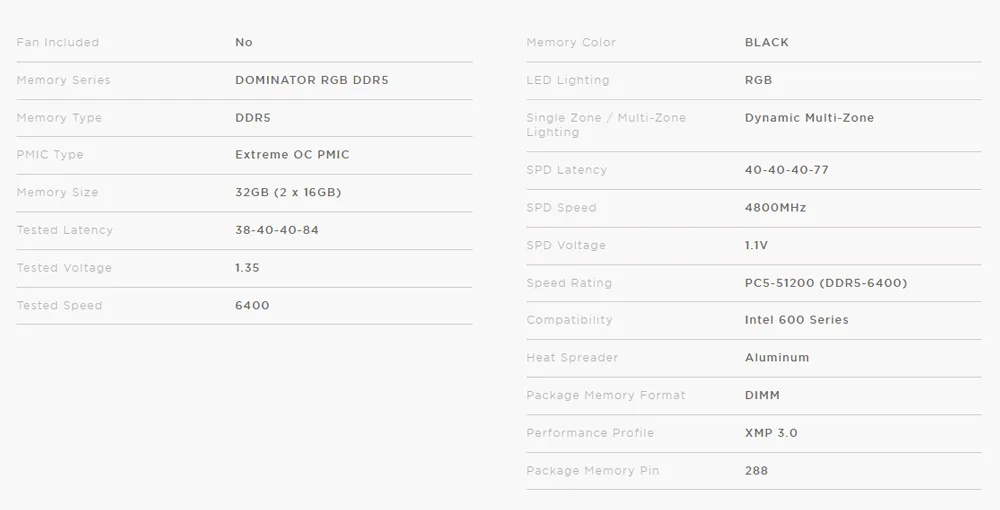
Corsair offers a lifetime warranty for their DOMINATOR DDR5 desktop memory.

We did not get the box from JPR, but the each memory DIMM arrived sealed in its anti-static blister pack.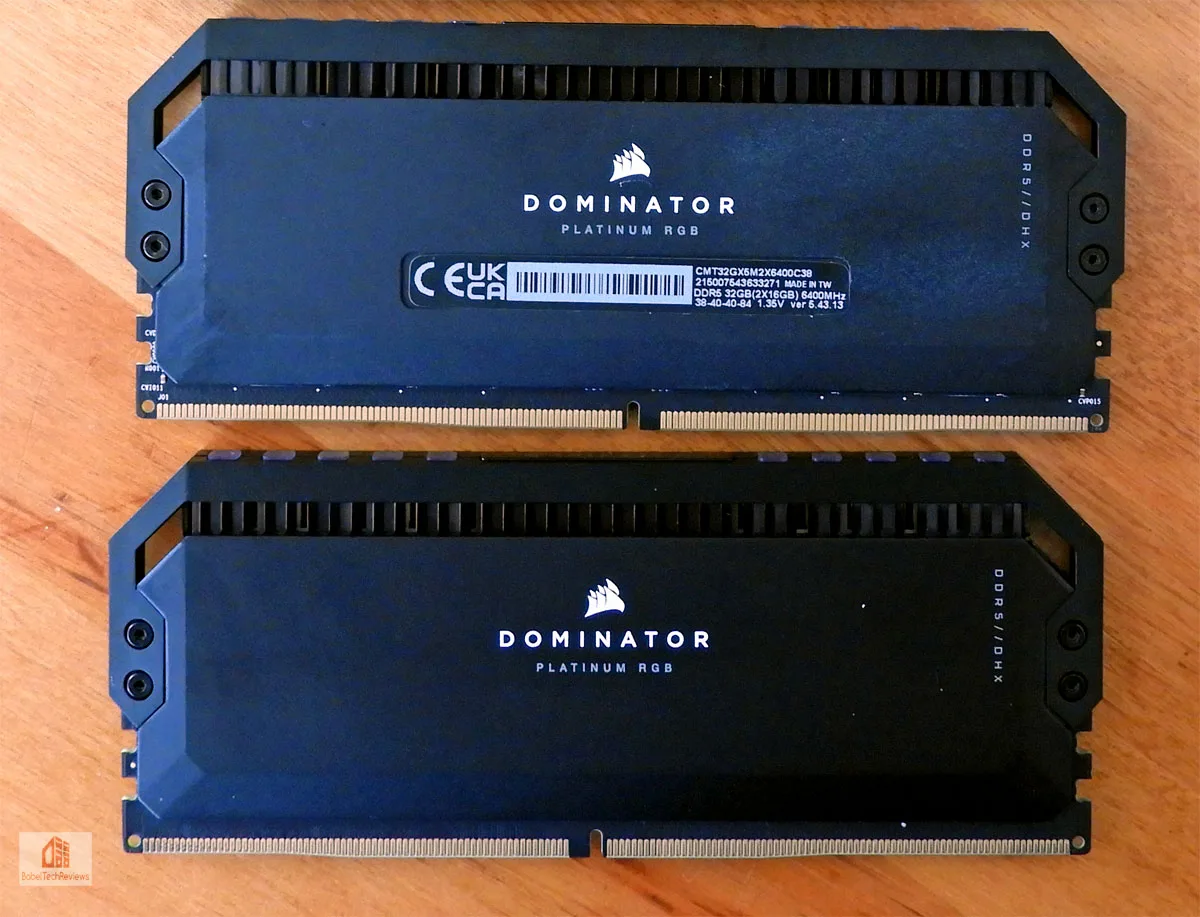
The memory is encased in a solid and heavy casing for cooling, and ever-changing aRGB lights run along its top and upper sides. 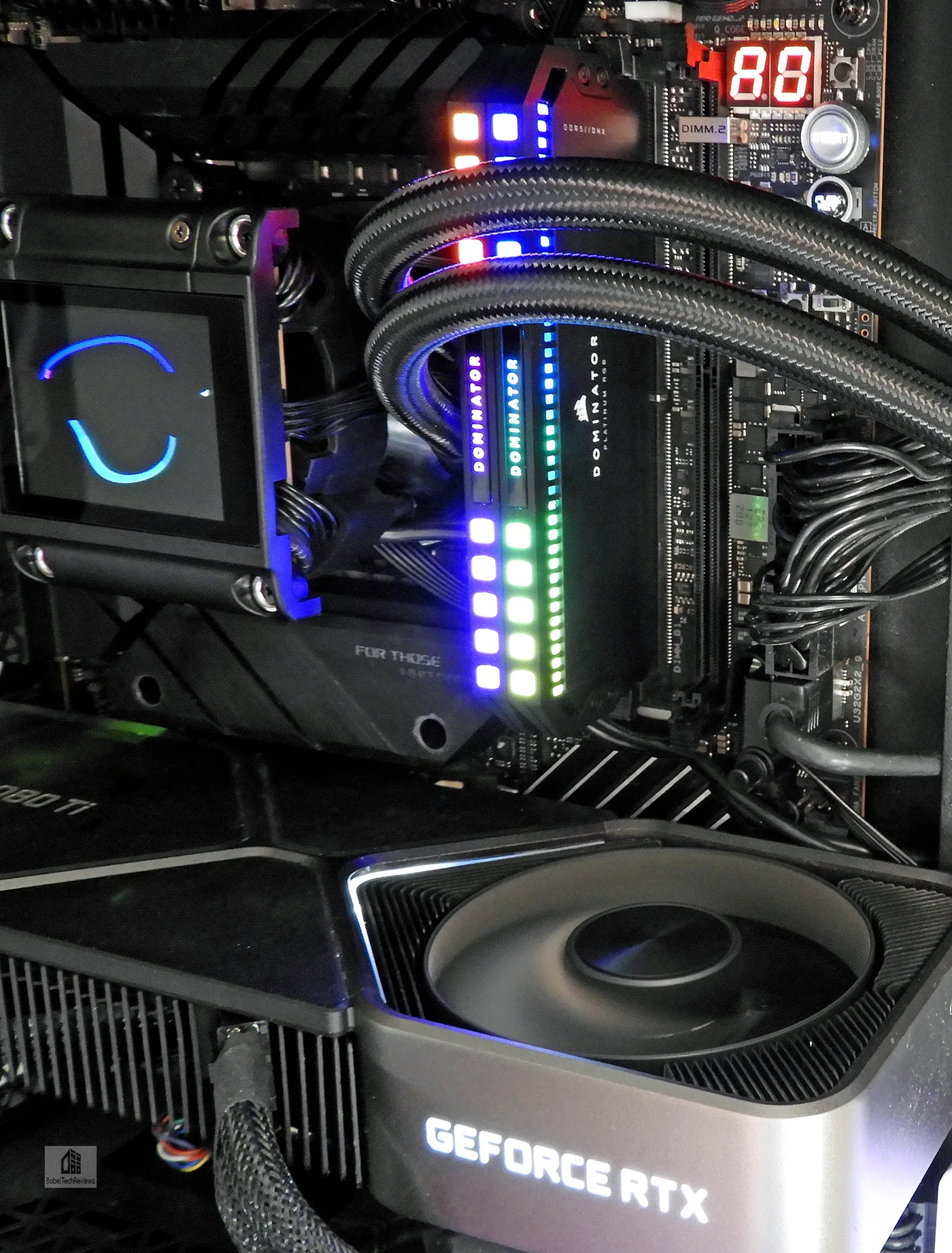
Corsair DOMINATOR DDR5 looks great installed in a PC and its specifications are outstanding. Let’s see how its performance compares with five other 2x16GB memory kits after a look at our test configuration.
Test Configuration – Hardware
- Intel Core i9-12900KF – HyperThreading and Turbo boost are on, stock settings.
- ASUS Prime Z690-P D4 LGA 1700 motherboard (Intel Z690 chipset, latest BIOS, PCIe 5.0, DDR4)
- ASUS ROG Maximus Z690 Apex LGA 1700 motherboard (Intel Z690 chipset, latest BIOS, PCIe 5.0, DDR5)
- Corsair DOMINATOR RGB PC5-51200 6400MHz DDR5 CL38 2x16GB kit, on loan from JPR
- T-FORCE DELTA RGB PC5-51200 6400MHz DDR5 CL40 2x16GB kit, supplied by TeamGroup
- G.SKILL Trident Z5 PC5-48000 6000MHz DDR5 CL36 2x16GB kit
- G.SKILL Trident Z5 PC5-48000 6000MHz DDR5 CL40 2x16GB kit
- T-FORCE VULCAN PC5-41600 5200MHz DDR5 CL40 2x16GB kit, supplied by TeamGroup
- T-FORCE VULCAN DARK Z PC4-28800 DDR4 3600MHz CL18 2x16GB kit, supplied by TeamGroup
- RTX 3080 Ti Founders Edition 11GB, at stock FE clocks, on loan from NVIDIA
- 2TB T-FORCE C-440 Ceramic NVMe SSD C: drive
- 1TB T-FORCE A-440 NVMe SSD for primary game storage, supplied by TeamGroup
- 1.92 TB San Disk enterprise class SSD for storage
- 2TB Micron 1100 SSD for storage
- 1TB Delta Max RGB SSD for storage, supplied by TeamGroup
- Super Flower Leadex Platinum SE 1200W 80+ Platinum power supply unit
- MSI MAG & MEG Series CORELIQUID 360R & 360S 360mm AIO CPU liquid coolers
- CORSAIR 5000D Mid-Tower ATX PC Case + 2 x 120mm + 1 x 140mm Noctua Fans
- BenQ 32″ 4K/60Hz display
Test Configuration – Software
- Nvidia’s GeForce 496.98 WHQL drivers. High Quality, prefer maximum performance, single display
- VSync is off in the control panel
- AA enabled as noted in games; all in-game settings are specified with 16xAF always applied
- Highest quality sound (stereo) used in all games
- Windows 11 Professional edition
- Latest DirectX
- MSI’s Afterburner
- CPU-Z
- Karhu RAM Test
- Windows Memory Diagnostics
30 PC Game suite
Vulkan
- DOOM Eternal
- Wolfenstein Youngblood
- Red Dead Redemption 2
- Ghost Recon: Breakpoint
- World War Z
- Strange Brigade
- Rainbow 6 Siege
DX12
- Guardians of the Galaxy
- Far Cry 6
- Resident Evil VIllage
- Metro Exodus – Enhanced Edition & regular edition
- Hitman 3
- DiRT 5
- Assassins Creed Valhala
- Watch Dogs Legions
- Horizon Zero Dawn
- Death Stranding
- F1 2020
- Borderlands 3
- Tom Clancy’s The Division 2
- Civilization VI – Gathering Storm Expansion
- Battlefield V
- Shadow of the Tomb Raider
DX11
- Chernobylite
- Days Gone
- Crysis Remastered
- Destiny 2 Shadowkeep
- Total War: Three Kingdoms
- Overwatch
- Grand Theft Auto V
Synthetic Game Benchmarks
- Firestrike
- TimeSpy
- VRMark
- Superposition
Synthetic/Real World Benching Suites & Tools
- SANDRA 2020/21 Engineer version courtesy of SiSoft
- AIDA64 courtesy of FinalWire
- PCMark 10 Professional Edition courtesy of UL
- SPECworkstation3
- 3DMark Professional Edition courtesy of UL
- Blender Benchmark
- Cinebench
- Frybench
- GeekBench
- RealBench
- Novabench
- CPU-Z benchmark
- 7-Zip benchmark
- Kraken JavaScript Bench
- Wprime
Nvidia Control Panel settings
Texture Filtering has been set to High with ‘prefer maximum performance’ power selected and V-sync disabled, but other settings are left stock.
CPU-Z gives details of the CPU and memory as well as providing a CPU benchmark.
CPU-Z
Here are Corsair’s DOMINATOR 6400MHz timings and voltage compared with JDEC standards below.

The SPD and Command Rate are set as below by the XMP BIOS profile for 3200MHz (x2 at 6400MHz).
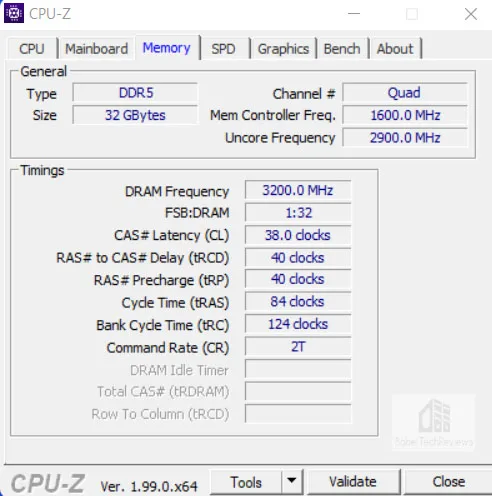
Let’s head to the detailed benching.
Benchmarking
Individual chart results are always listed in order: 1) Corsair DOMINATOR DDR5 6400 CL38, 2) DELTA RGB DDR5 6400 CL40, 3) G.SKILL TridentZ5 DDR5 6000 CL36, 4) G.SKILL TridentZ5 DDR5 6000 CL40, 5) Vulcan 5200MHz DDR5 CL40, and 3) DARKZ 3600 DDR4 CL18.
“Wins” – the highest scores or fastest times – are denoted by Red text on the summary charts. In case of a tie (or ties), both (or all) tying figures will be presented in red.
Synthetic and Real World Benches
SiSoft Sandra 2020/21
To see where memory performance results differ, and there is no better tool than SiSoft’s Sandra 2020/21. SiSoftware Sandra (the System ANalyser, Diagnostic and Reporting Assistant) is an complete information & diagnostic utility in a complete package. It is able to provide all the information about your hardware, software and other devices for diagnosis and for benchmarking. Sandra is derived from a Greek name that implies “defender” or “helper”.
There are several versions of Sandra, including a free version of Sandra Lite that anyone can download and use. It is highly recommended! We are using the full engineer suite courtesy of SiSoft. The latest version features multiple improvements over earlier versions of Sandra. It will benchmark and analyze all of the important PC subsystems and even rank your PC and give recommendations for improvement.
We run Sandra memory intensive benchmark tests focusing first on the CPU. Here is the chart summarizing the results.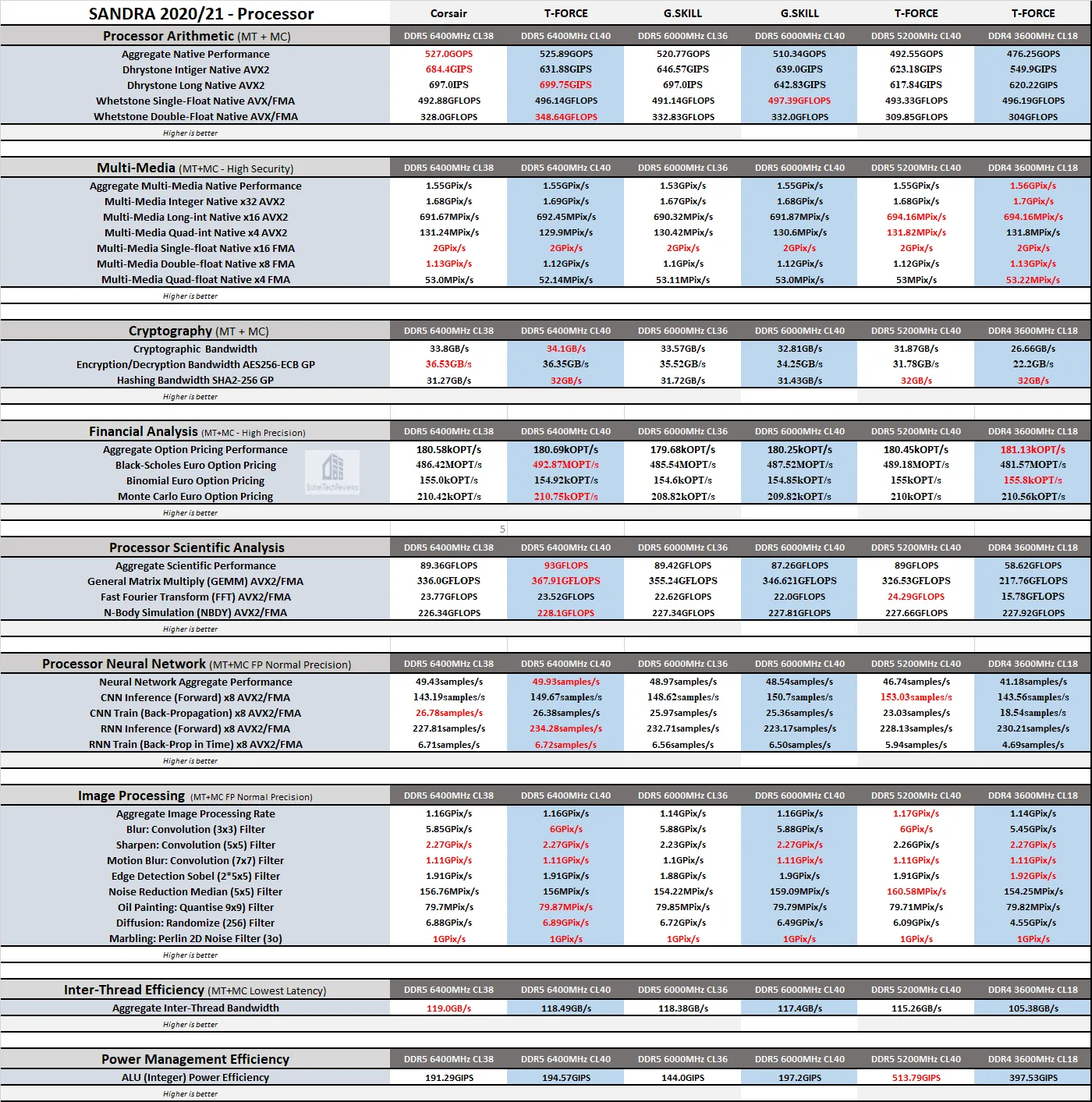
The T-FORCE Delta 6400 CL40 wins the lion’s share of Sandra’s synthetic benches followed by the DDR4 memory, then the Dominator DDR4 3600 CL18 memory. The G.SKILL DDR5 6000 CL36 memory tends to score higher than the CL40 kit while the 5200MHz memory is the slowest DDR5 but it does well in image processing and multi-media.
Here are the memory controller tests.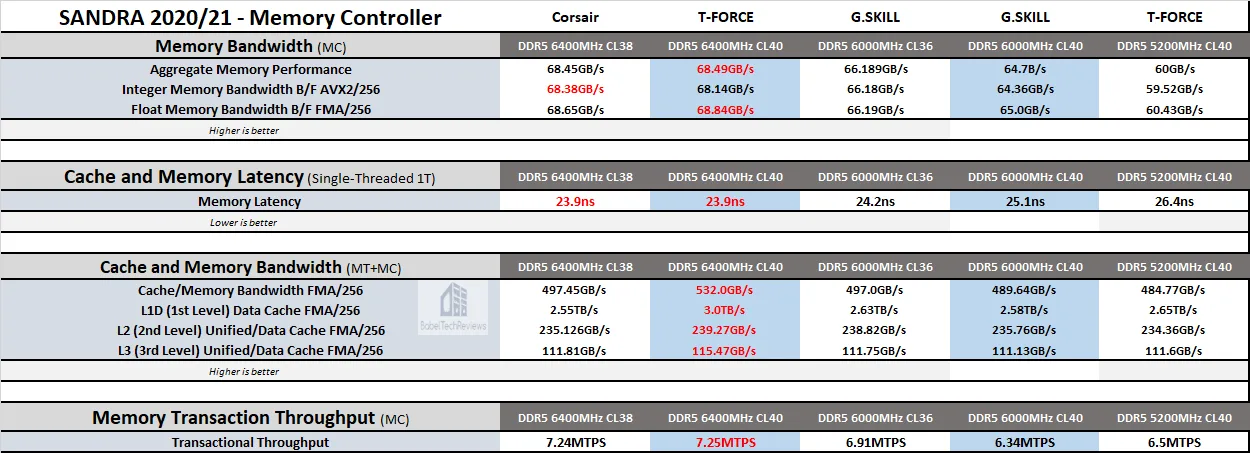
In most Sandra memory controller tests, the T-FORCE DDR5 6400MHz CL40 is the fastest with the Corsair DDR5 6400MHz in second place. G.SKILL’s 6000MHz CL36 scores higher than the CL40, and the 5200MHz DDR5 brings up the rear.
We next feature AIDA64.
AIDA64 v6.60.5900
AIDA64 is the successor to Everest and remains an important industry tool for benchmarkers. Its memory bandwidth benchmarks (Memory Read, Memory Write, and Memory Copy) measure the maximum available memory data transfer bandwidth. AIDA64’s benchmark code methods are written in Assembly language, and they are well-optimized for every popular AMD, Intel and VIA processor core variants by utilizing the appropriate instruction set extensions. We use the Engineer’s full version of AIDA64 courtesy of FinalWire. AIDA64 is free to to try and use for 30 days.
The AIDA64 Memory Latency benchmark measures the typical delay from when the CPU reads data from system memory. Memory latency time means the time is accurately measured from the issuing of the read command until the data arrives to the integer registers of the CPU. It also tests Memory Read, Write, and Copy speeds besides Cache.
Here are the Corsair DOMINATOR 6400 CL38 Cache & Memory Benchmark results.
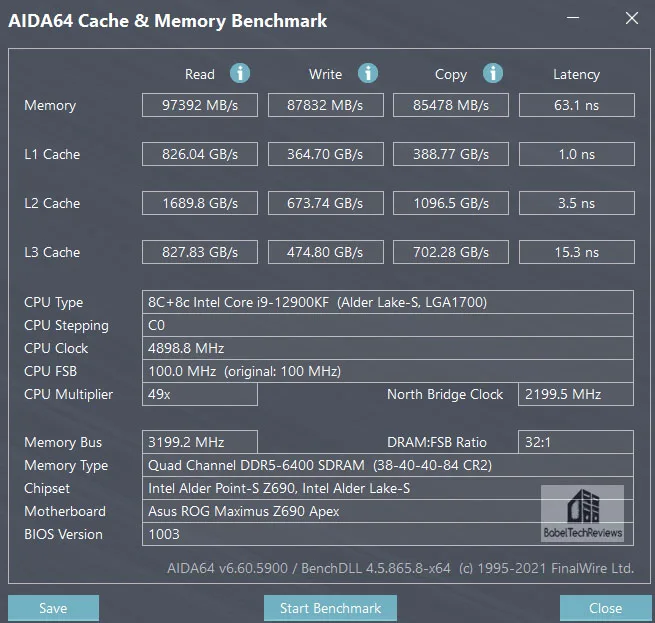
Here is the summary chart.

The AIDA64 memory benchmarks that depend on fast memory show that Corsair’s DOMINATOR 6400 CL38 leads except for Memory Read where the Delta 6400 CL40 wins, and we note that DDR4 has lower latency. Next we test the AIDA64 CPU benchmarks.

The CPU benchmarks show DDR4 as the fastest with the exception of PhotoWorxx. The AIDA64 FPU benchmark summary chart is next.

The AIDA64 FPU benchmarks results are less dependent on memory than the CPU benches and the results are similar but once again, the DDR4 equipped PC leads.
Let’s look at PCMark 10 next to see if its benchmarks can reflect memory speed increases.
PCMark 10 Professional Edition
PCMark 10 has multiple tests which use real world timed benchmarks including web browsing, video group chat, photo, batch, and video editing, music and video tests, and even mainstream gaming. The PCMark 10 test offers three primary tests and we chose the Extended and also the Express version. We use the Professional Edition courtesy of UL.
Here are the DOMINATOR 6400MHz CL38 Express version online results which show the individual test results.
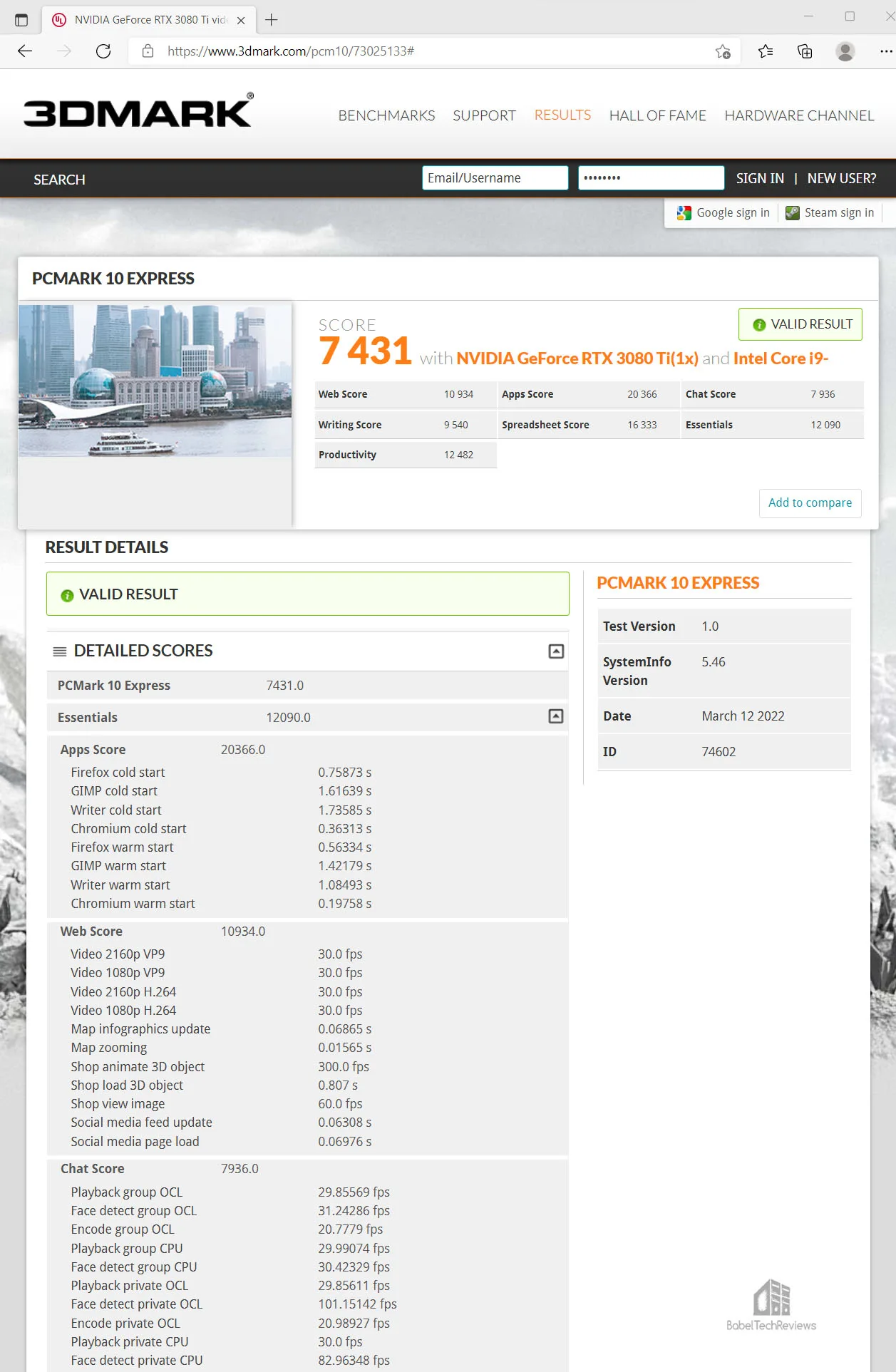
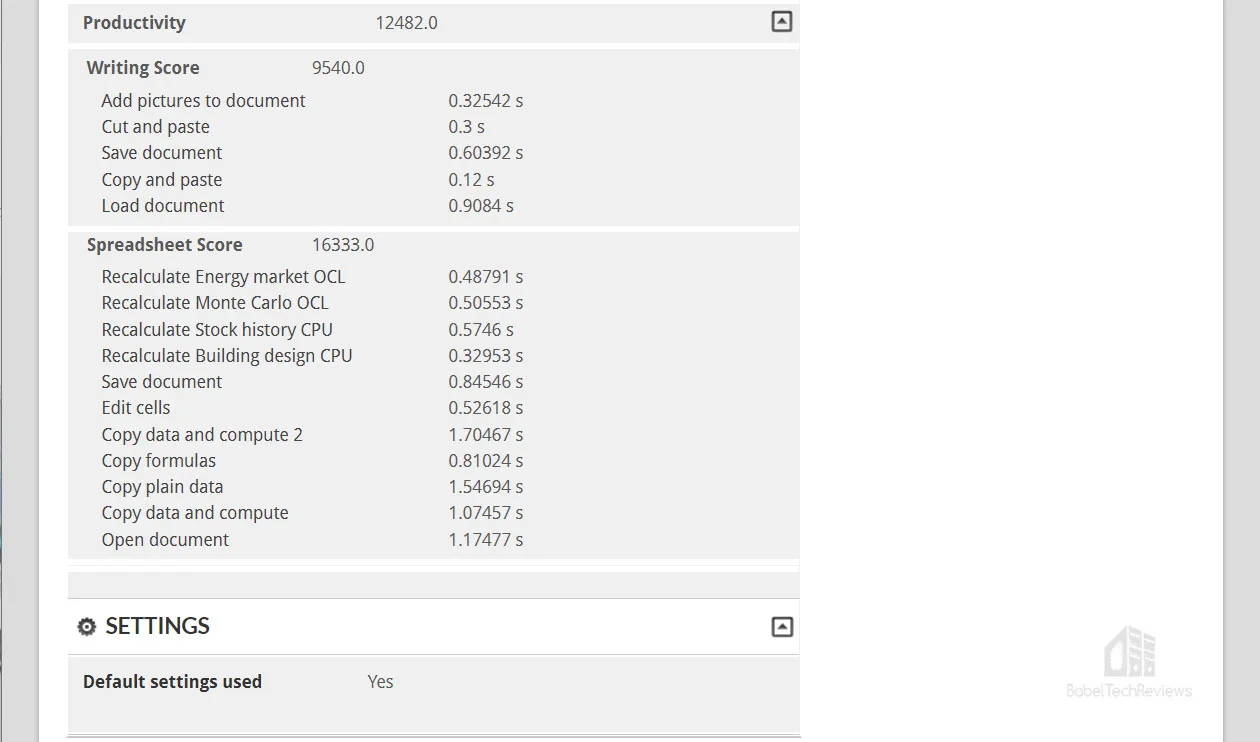
The summary chart is shown after the Extended benchmarks.
EXTENDED
Next are the Extended version online results that show the individual test results.

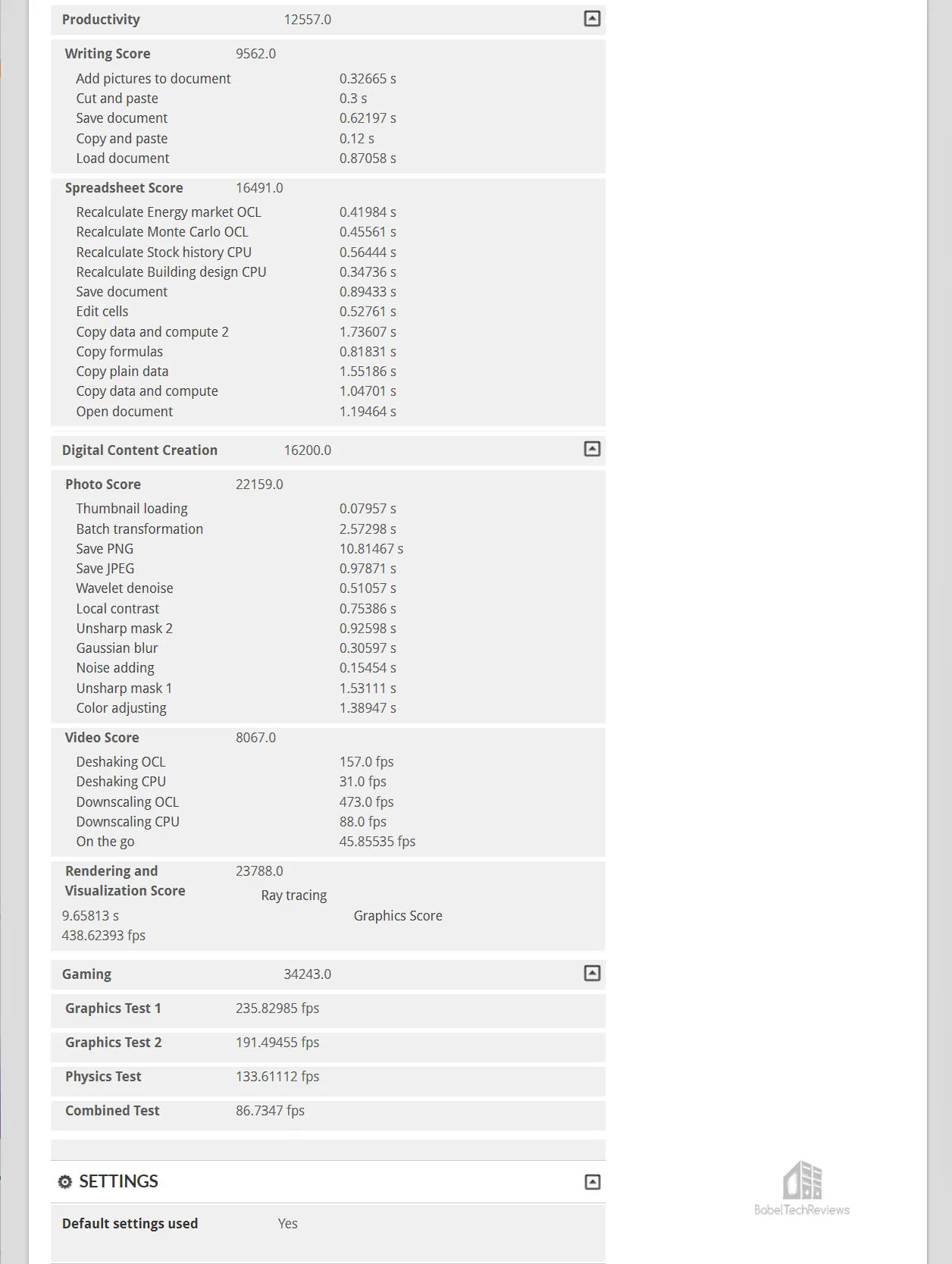
Here is the summary.

It may be that memory speeds don’t make a significance difference to the overall score in PCMark 10 benchmarks as the slowest DDR5 scores the highest in the Extended test. Let’s check out SPECworkstation3 benchmarks next.
SPECworkstation3 Benchmarks
All of the SPECworkstation3 benchmarks are based on professional applications, most of which are in the CAD/CAM or media and entertainment fields. All of these benchmarks are free except for vendors of computer-related products and/or services.
The most comprehensive workstation benchmark is SPECworkstation3. It’s a free-standing benchmark which does not require ancillary software. It measures GPU, CPU, storage and all other major aspects of workstation performance based on actual applications and representative workloads. We only tested CPU-related workstation performance.
Here are our SPECworkstation 3.1.0 summary and raw scores for the DOMINATOR 6400MHz CL18 equipped PC.
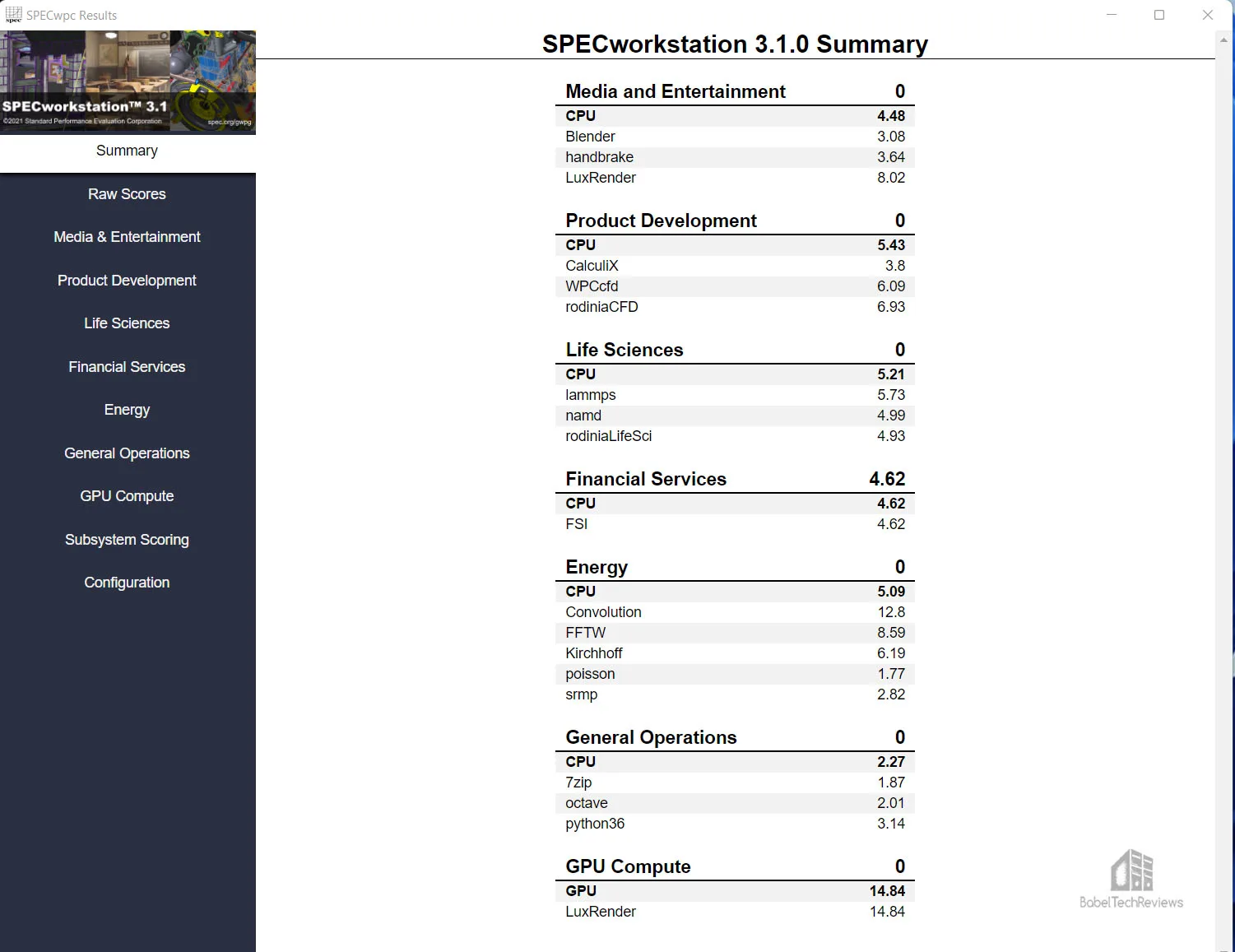
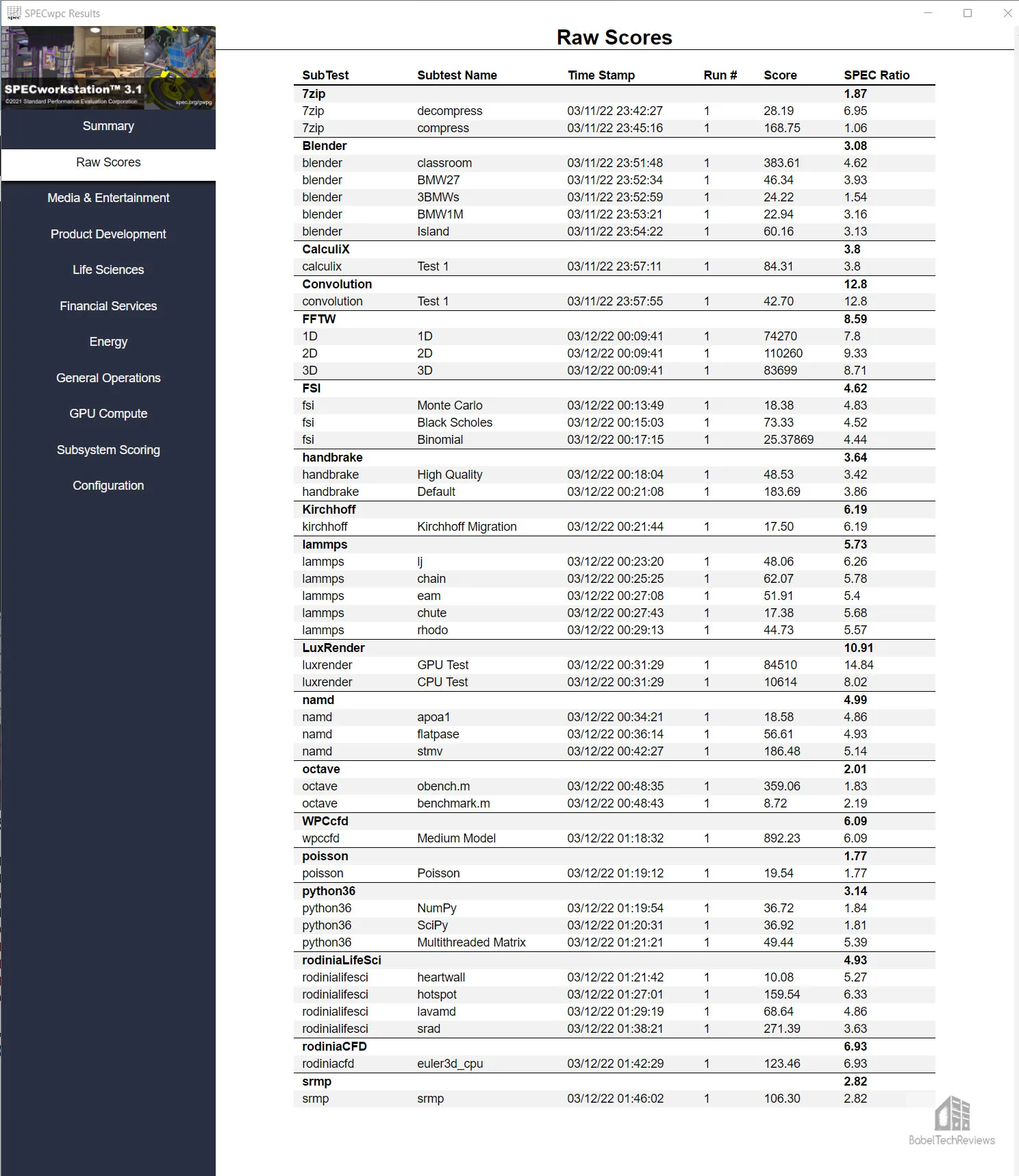
Here is the summary of the five DDR5-equipped PCs compared side-by-side with the DDR4 PC.

In most benchmarks, the DELTA DDR5 6400MHz CL40 equipped PC leads followed by the DOMINATOR 6400MHz CL38 memory.
Let’s take a look at Blender.
Blender 3.0.1 Benchmark
We generally see performance increase with faster CPU and memory speeds, so we used the very latest version of the Blender 3.0.1 benchmark which primarily measures CPU performance in rendering production files. Higher is better as the benchmark automatically renders a scene multiple times and gives the results as samples per minute. It may be downloaded from here.
The DOMINATOR 6400MHz CL38 Blender results are shown below.

Here is the Summary.

Interestingly, the G.SKILL DDR5 6000MHz CL36 kit is fastest in the Blender benchmark.
Next we benchmark using Cinebench.
Cinebench
Cinebench is based on MAXON’s professional 3D content creation suite, Cinema 4D. This latest R23 version of Cinebench can test up to 64 processor threads accurately and automatically. It is an excellent tool to compare CPU/memory performance and higher is better.
The DOMINATOR 6400MHz CL38 Cinebench results are shown below.
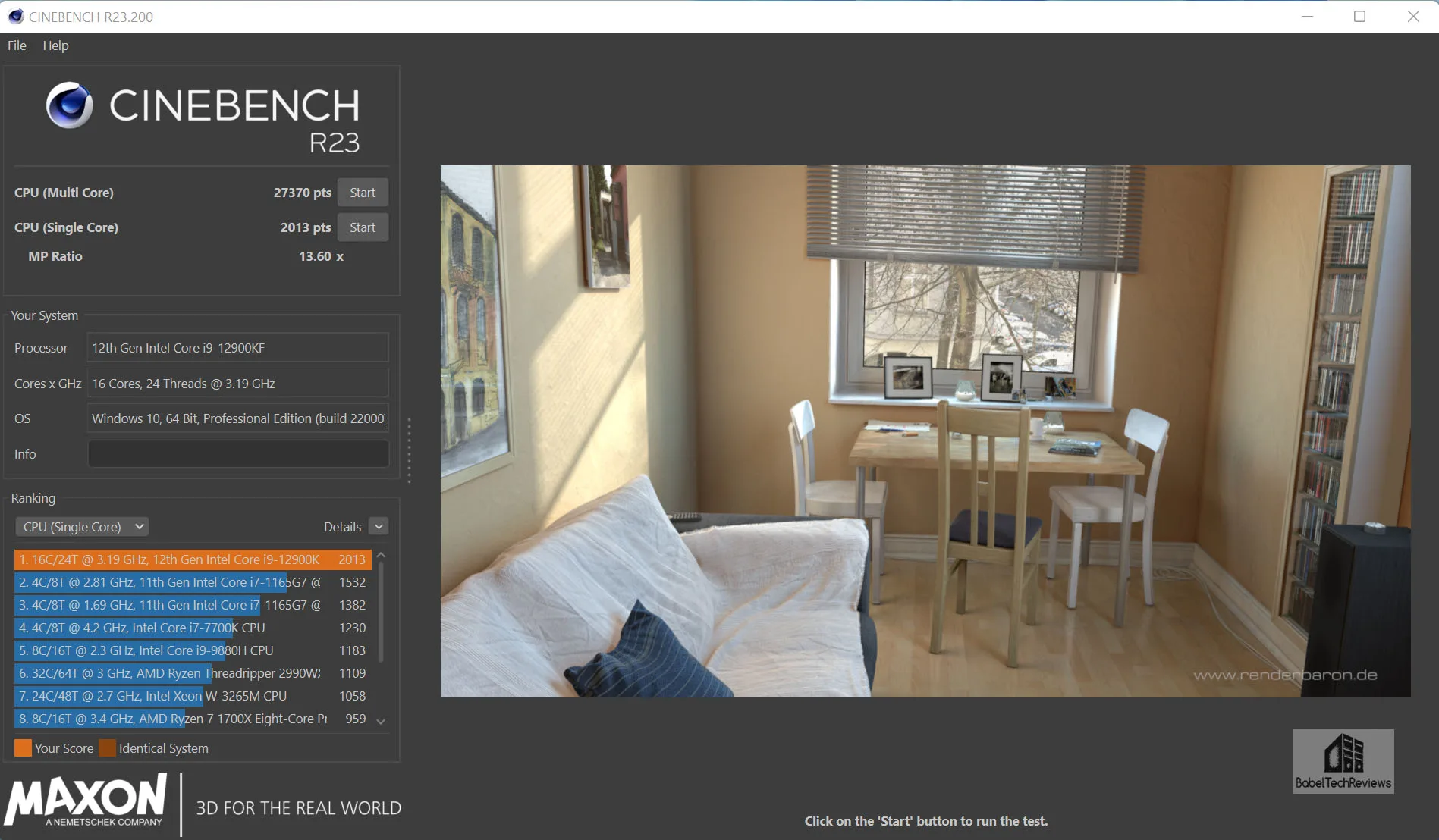
Now the summary chart.

The T-FORCE DELTA 6400MHz CL40 DDR5 equipped PC gives the highest Cinebench scores.
Let’s look at Frybench next.
Frybench
Frybench developed by RandomControl is an older light simulation benchmark that uses Fryrender in a similar manner as Cinebench uses the Cinema Rendering engine. The objective is to render as quickly as possible so lower is better.
The DOMINATOR 6400MHz CL38 equipped PC completes the Frybench render in 56 seconds.
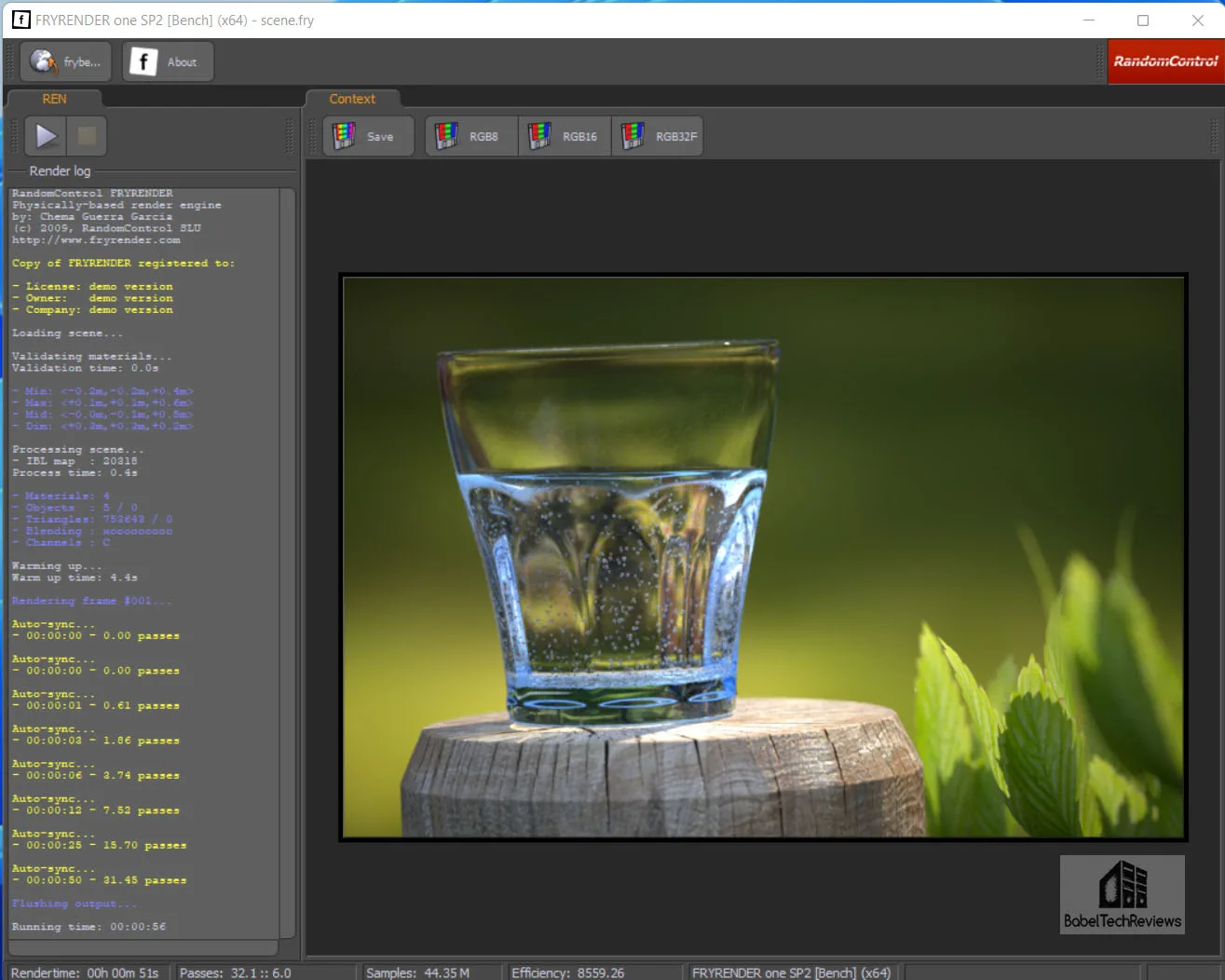
Here is the summary chart.

The DDR5 6400 CL38 and CL36 and the DDR5 6000 CL36 PCs all complete the render the quickest followed by the DDR5 6000 CL40 and DDR4 PC followed in last place by the DDR4 5200MHz PC. Do a couple of seconds matter? It may depends on if the PC is primarily used for rendering.
Next up, GeekBench.
GeekBench
GeekBench is an excellent CPU benchmarking program which runs a series of tests and times how long the processor takes to complete the tasks. Faster memory means the CPU may be able to complete tasks faster.
The DOMINATOR 6400MHz CL38 GeekBench overall results are next.
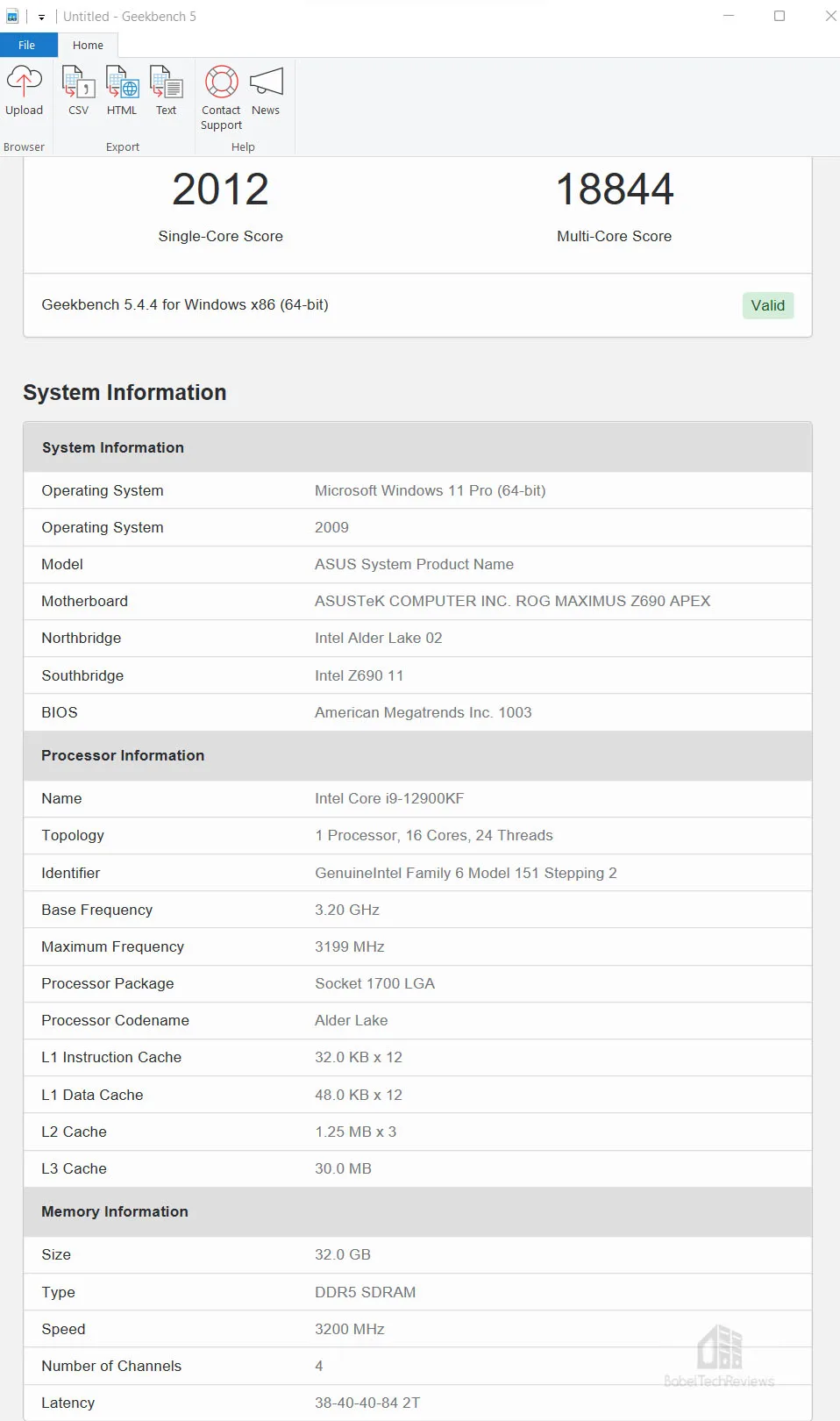
Single-core results follow.
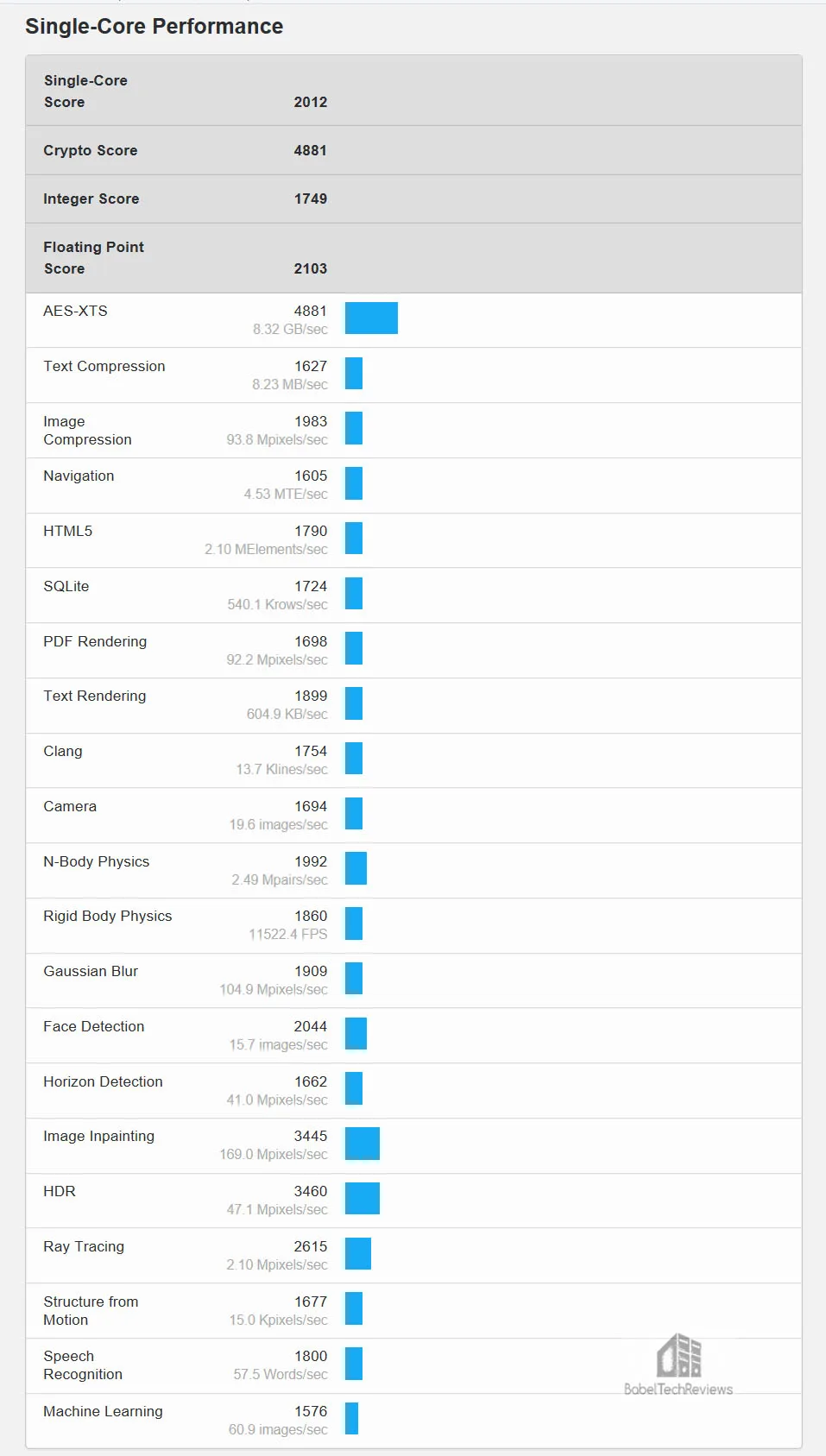
Finally, the multi-core results are presented below.

Here is the Geekbench summary chart.

The Delta DDR5 6400MHz CL40 equipped PC scores highest.
Next we check out Real Bench.
RealBench v2.56
RealBench is a benchmarking utility by ASUS Republic of Gamers which benchmarks image editing, encoding, OpenCL, Heavy Multitasking, and gives an overall score. Some of these tests are affected by CPU and memory speeds
The DOMINATOR 6400MHz equipped PC scores 361,015.
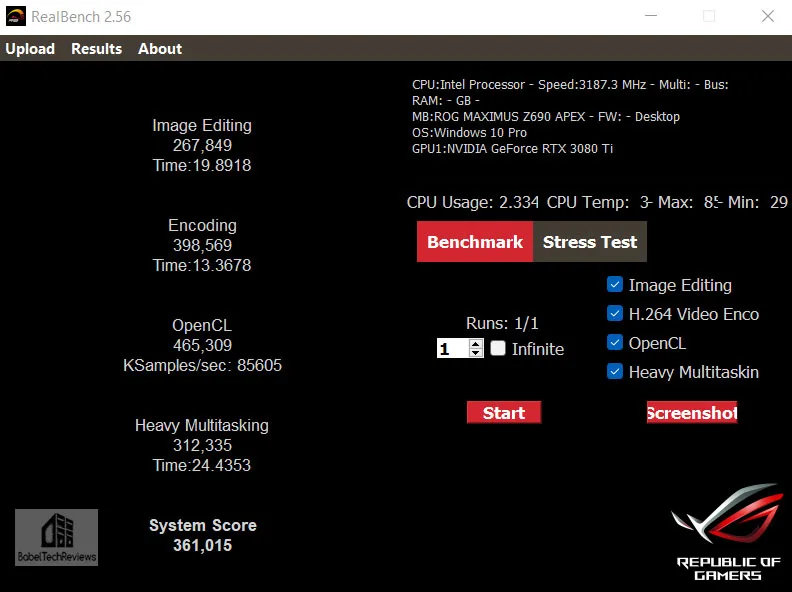
Here are the individual tests summarized and compared.

RealBench results favor the DELTA 6400MHz CL40 equipped PC, however, the Dark Z 3600MHz DDR4 PC is fastest for Image Editing.
Next up, Novabench.
Novabench
Novabench is a very quick benching utility that also gives a memory score which shows the overall bandwidth speeds.
The DOMINATOR 6400MHz equipped PC RAM score is 368.
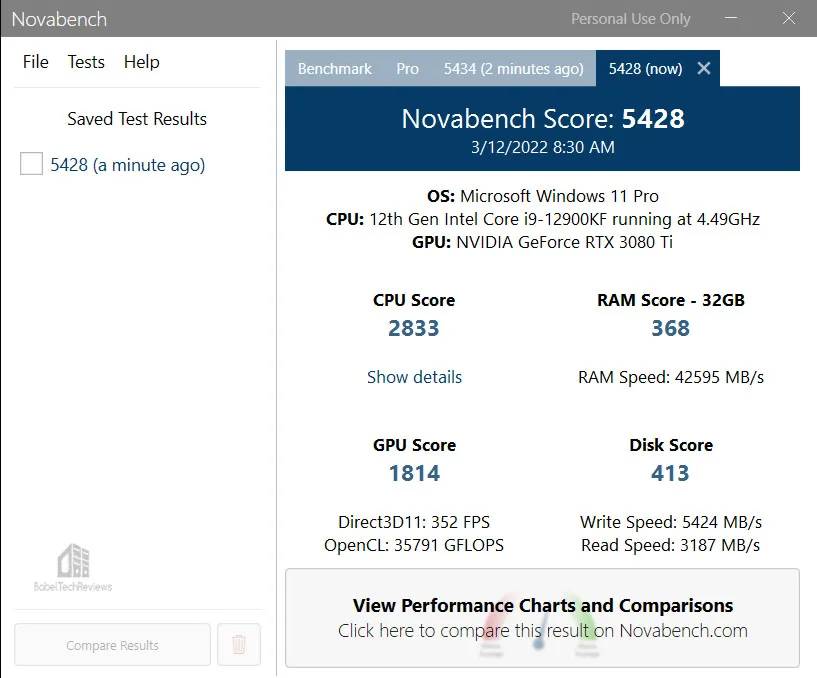
Here are the Novabench memory scores summarized in a chart.

The Novabench results show the DELTA RGB DDR5 6400MHz CL40 PC has the fastest memory score followed by the DOMINATOR 6400MHz CL38 equipped PC.
Next up is CPU-Z benchmark.
CPU-Z bench
The CPU-Z benchmark can show differences in IPC between CPUs to generate a score to compare both CPU single-core and multi-core performance.
The Corsair DOMINATOR 6400MHz CL38 equipped PC scores 819.8 single-core and 11411.7 multi-core.

Here is the summary

This time, the DDR4-equipped PC scores highest in the multi-core test, but the DELTA PC scores highest in the single core test.
Z-Zip benchmark is next.
7-Zip benchmark
The 7-Zip benchmark tests LZMA compression/decompression and gives a rating in MIPS (million instructions per second) which is calculated from the measured speed. It is somewhat dependent on RAM speeds.

The summary shows the DELTA DDR5 equipped PC is the fastest.
On to Wprime and number crunching.
WPrime v2.10
WPrime is a multi-threaded benchmark which can show the differences in IPC between CPUs, and faster memory may also make a difference. We use 24 threads and we choose to calculate 1024 million digits and 32 million digits using multiple runs.
The Corsair DOMINATOR 6400MHz equipped PC Wprime results are below.
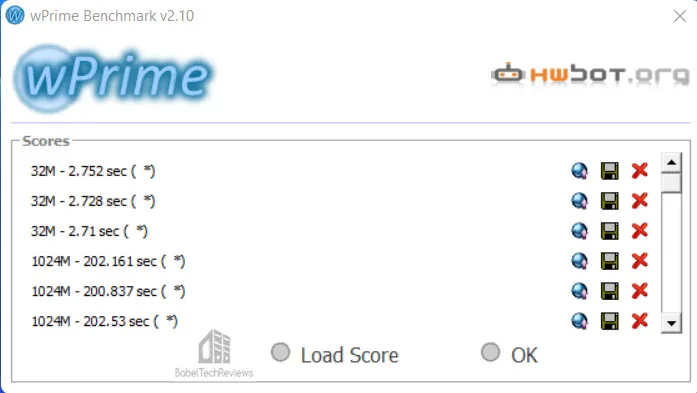
Here is the Wprime comparison chart with the fastest numbers from each set of runs compared. Lower/quicker is better.

The DDR4 PC is overall the fastest with the DDR5 5200 equipped PC in last place.
The Kraken JavaScript benchmark is the last of our non-gaming benches.
Kraken JavaScript Benchmark
The Kraken JavaScript benchmark was created by Mozilla to measures the speed of several different tests based on the SunSpider benchmark. The results are reported in milliseconds and lower (quicker) is better.
The Corsair DOMINATOR 6400MHz CL38 equipped PC Kraken JavaScript bench results are below.
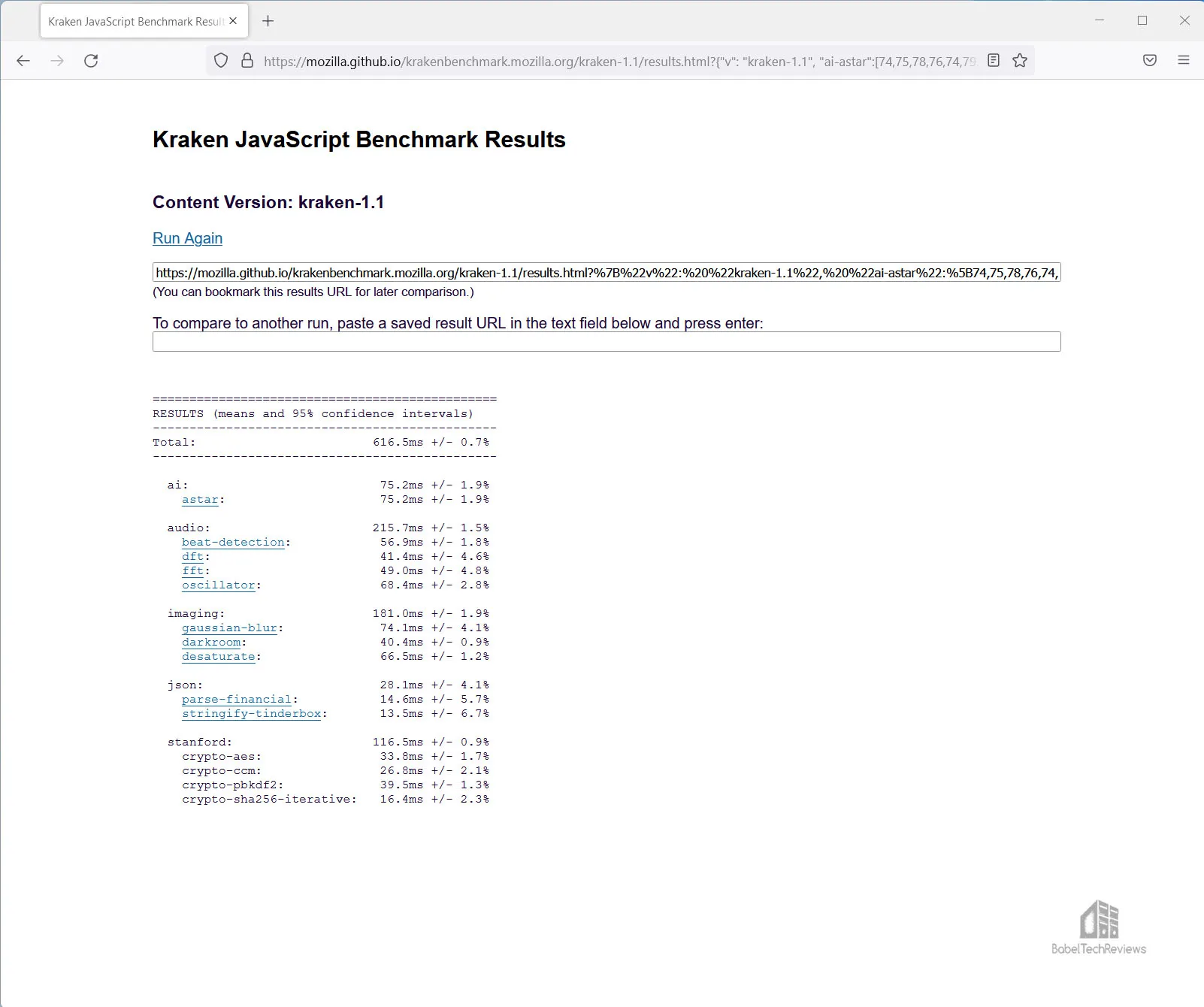
Here is the summary:

This time, the G.SKILL DDR5 6000 CL36 equipped PC is fastest.
Next, the gaming benchmarks, the summary charts, and the conclusion.
Game Performance Results, Summary Charts, & Conclusion
Gaming Performance Summary Charts
Here are the summary charts of 30 games and 6 synthetic tests. The highest settings were always chosen and the settings are listed on the charts. The benches were run at 1920×1080, 2560×1440 and at 3840×2160 to compare DDR performance.
The results, except for synthetic scores, show average framerates, and higher is better. Minimum framerates are next to the averages in italics and in a slightly smaller font. Indicated on the chart are runs benched with OCAT that show the 1% lows (99 percentiles) converted to FPS. This time, “Wins” are denoted by Yellow text. If there is a tie (or ties), they will all be in yellow.
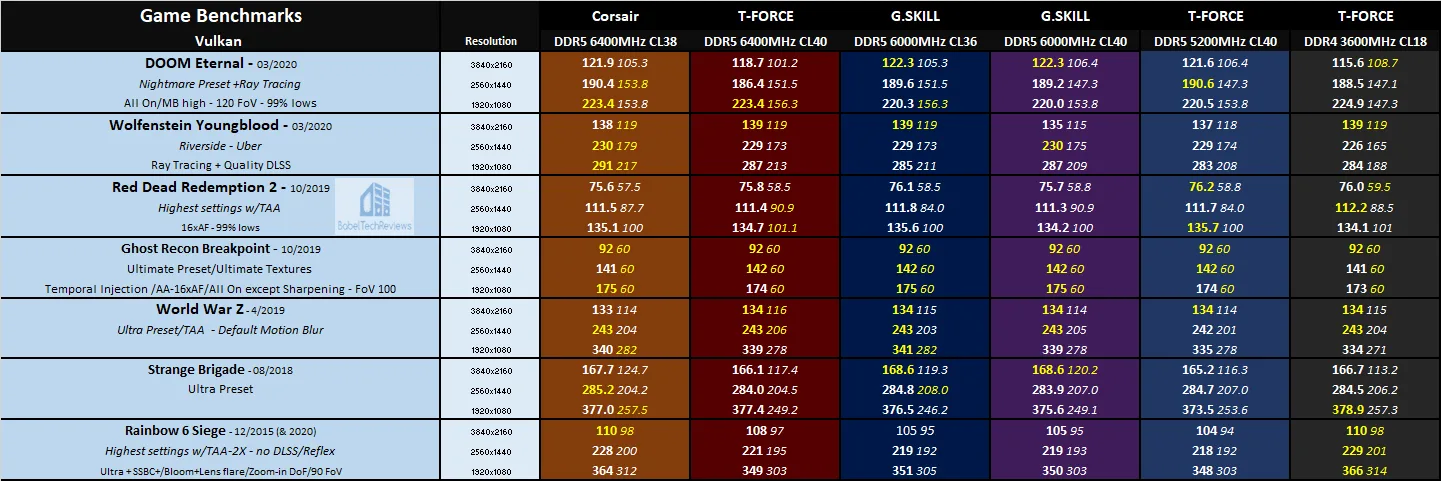
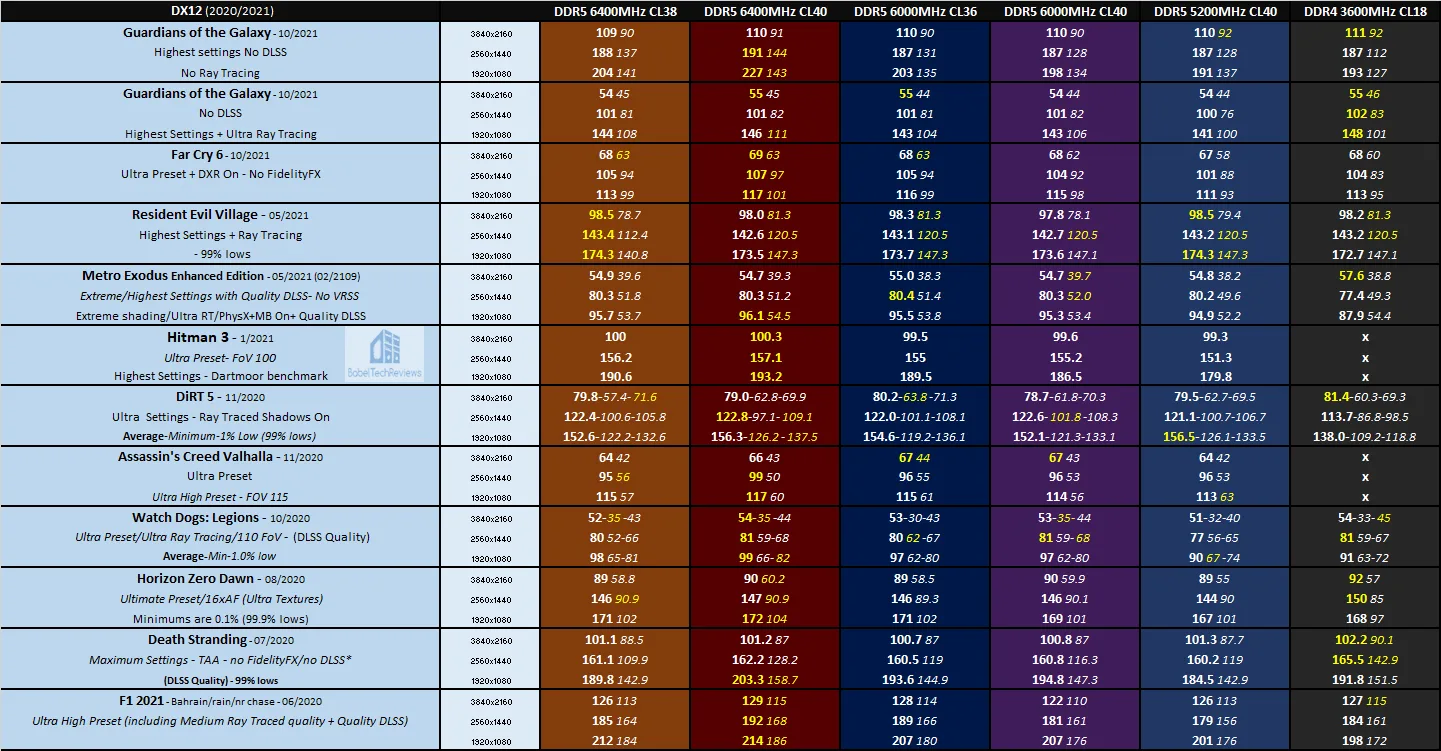


 Although the benchmarking margin of error may cloud the results, there is a trend showing that although the DDR5-equipped PCs are faster in some games, others show higher framerates for the DDR4 equipped PC. Comparing just the average framerates, the DELTA 6400 CL40 DDR5 equipped PC has the most wins followed by the DDR4 PC and the DOMINATOR 6400 CL38 PC.
Although the benchmarking margin of error may cloud the results, there is a trend showing that although the DDR5-equipped PCs are faster in some games, others show higher framerates for the DDR4 equipped PC. Comparing just the average framerates, the DELTA 6400 CL40 DDR5 equipped PC has the most wins followed by the DDR4 PC and the DOMINATOR 6400 CL38 PC.
Several trends are notable with the DDR5 PCs. Generally the fastest memory gives the highest framerates and the G.SKILL DDR5 6000 CL36 is faster than CL40. However, the the Corsair 6400 CL38 isn’t faster than the T-FORCE 6400 CL40. This may be somewhat dependent on how the ASUS ROG motherboard optimizes its BIOS and XMP Profiles for each manufacturer’s memory.
Synthetic & Real World Summary Charts
Here are all of the summary charts presented again without comment.


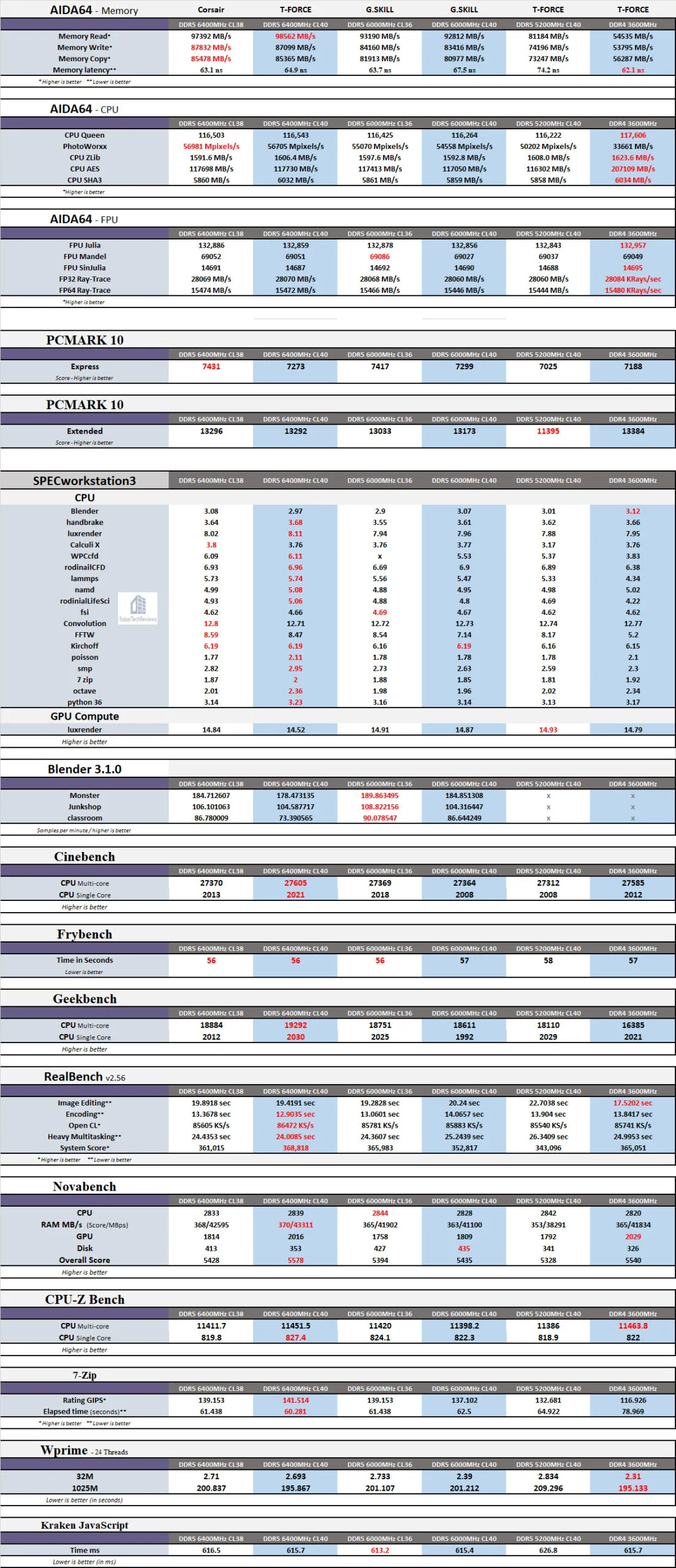
Let’s head for the conclusion.
Conclusion and Verdict
Running DDR memory at faster clock speeds generally results in performance gains and saves time with multiple applications. In addition, some CPU-dependent games may benefit from faster system memory and the higher bandwidth of DDR5. However, the higher latency and lower clockspeeds of Vulcan DDR5 5200MHz platform appear to put it at an overall disadvantage versus the DDR4 3600MHz platform. This is not the case with either the DDR5 6400MHz CL40 or CL36 equipped PC where they are generally faster than the other memory kits we tested. We’d suggest that a gamer who prefers DDR5 choose a kit that is at least 6000MHz.
The G.SKILL DDR5 6000 CL36 kit is overall faster than the same memory at CL40 although there doesn’t appear to be any performance advantage the Corsair DDR5 6400 CL38 has over the same speed T-FORCE memory at CL40. This may possibly be due to the way the ASUS motherboard optimizes each manufacturer’s XMP profile in the BIOS.
We recommend the Corsair DOMINATOR DDR5 6400 CL38 2x16GB kit with the caveat being its price. It is expensive at $484.99. The T-FORCE DELTA MSRP is evidently $399.99 and it is slightly faster in our testing. At Newegg, Delta is priced at $559, but it’s part of a bundle which includes a fast 5,000MB/s 1TB CARDEA ZERO Z440 M.2 2280 PCIe Gen 4.0 x4 SSD ($124.99).
The Corsair DOMINATOR DDR5 6400 CL38 is a difficult recommendation to make except to the gamers with a top PC who want great-looking RGB memory with the best performance at any price. For budget 12th generation Intel gamers, stick with fast DDR4, and Corsair offers an excellent selection of very fast and low latency DDR4 3600.

For the gamer who wants the best performance, the Corsair DOMINATOR DDR5 6400 CL38 memory not only looks great with RGB, it performs very well. It is backed by Corsair who offers a lifetime warranty.
Next up for this week is Rodrigo’s new review of Z690 NVIDIA Resizable BAR performance. Stay tuned.
Happy Gaming!
Comments are closed.